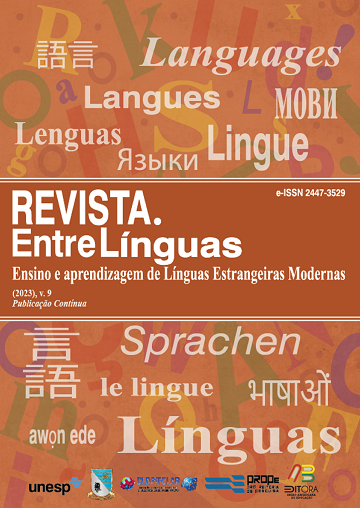Tecnología educativa y principios y métodos de enseñanza del inglés
DOI:
https://doi.org/10.29051/el.v9i00.17747Palabras clave:
Tecnología educativa, Mejora de la calidad, Inglês, Educación tradicionalResumen
Los medios didácticos como interfaz han sabido desempeñar bien su papel. Será mejor si los profesores tienen las habilidades necesarias para usar estas herramientas. Hoy en día, los expertos y pensadores de todo el mundo enfatizan la importancia y la determinación del papel de la tecnología educativa en el proceso de aprendizaje y creen que el uso óptimo de los medios de enseñanza en lugar de maestros y maestros tendrá un efecto constructivo en la mejora de la calidad de la educación. Debido a los problemas del sistema educativo de nuestro país en la enseñanza del inglés y la falta de habilidades de los estudiantes capacitados, especialmente en hablar, escuchar y escribir, muchos padres tratan de cubrir esta carencia en el sistema educativo recurriendo a escuelas avanzadas. Por lo tanto, en este artículo, decidimos examinar el papel de la enseñanza de tecnologías de asistencia para facilitar la enseñanza del idioma inglés en las aulas.
Descargas
Citas
ATKINS, N. E.; VASU, E. S. Measuring knowledge of technology usage and stages of concern about computing: A study of middle school teachers. Journal of Technology and Teacher Education, v. 8, n. 4, p. 279-302, 2000.
EGBERT, J. L.; PAULUS, T. M.; NAKAMICHI, Y. The impact of CALL instruction on classroom computer use: A foundation for rethinking technology in teacher education. Language Learning & Technology, v. 6, 2002.
FETSCO, T.; MC CLURE, J. Educational psychology. New York: Allyn and Bacon, 2005.
HANSON-SMITH, E. Classroom practice: Using multimedia for input and interaction in CALL environments. In: HANSON-SMITH, E. (Ed.). CALL environments: Research, practice, and critical issues. Alexandria, VA: TESOL, 1999. p. 189-215.
HOFSTETER, F. T. Multimedia literacy. NY: MC Grow – Hill, 1996.
JOHNSON, D.; EISENBERG, M. Learning and Teaching Information Technology Computer Skills in Context. ERIC Digest, 2006.
JONES, J. E. Computer Simulated Experiments in High School Physics and chemistry. 1972. 127 f. Dissertation (Doctorate) – Iowa State University, 1972.
KIM, H. Teachers as a barrier to technology-integrated language teaching. English Teaching, v. 57, n. 2, p. 35-64, 2002.
KULIK, J. A.; BANGART, R. L.; WILLIAMS, G. W. Effects of Computer Based Learning on Secondary School Students. Journal of Educational Psychology, v. 75, p. 12-26, 1983.
LABORDA, J. G.; ROYO, T. M. Educational Technology & Society, v. 10, n. 3, p. 320-324, 2007.
LAM, Y. Technophiliacs, technophobia: A preliminary look at why secondlanguage teachers do or do not use technology in their classrooms. Canadian Modem Language Review, v. 56, n. 3, p. 389-420, 2000.
MORGIL, I. et al. Traditional and computer – assisted learning in teaching acid and bases. Chemical Education Research and Practice (CERP), v. 6, n. 2, p. 52- 63, 2005.
ORTIZ, A. English language learning with special needs; Effective instructional strategies. Journal of Learning Disabilities, v. 30, p. 420-321, 2007.
PARK, C.; SON, J.-B. Implementing Computer-Assisted Language Learning in the EFL Classroom: Teachers’ Perceptions and Perspectives. International Journal of Pedagogies and Learning, v. 5, n. 2, p. 80-101, 2009.
REAMON, D. T.; SHEPPARD, S. D. The role of simulation software in an ideal learning environment. In: DESIGN ENGINEERING TECHNICAL CONFERENCES, 1997, Sacramento. Proceedings […]. Sacramento, CA, 1997.
SCHACTER, J. The Impact of Educational Technology on Student Achievement: What the Most Current Research Has to Say. ERIC Digest, 1999.
SHIN, H.-J.; SON, J.-B. EFL teachers' perceptions and perspectives on Internetassisted language teaching. CALL-EJ Online, v. 8, n. 2, p. 14-31, 2007.
SWAIN, N. K.; ANDERSON, J. A.; KORRAPATI, R. B. Role of simulation software in enhancing student learning in computer organization and microcontroller courses. In: INTERNATIONAL CONFERENCE, 2008, Nashville. Proceedings […]. Nashville, TN, USA, 2008. Available: http://www.ijme. us/cd_08/PDF/135%20ENT%20207.pdf. Access: 10 Jan. 2022.
WENGLINSKY, H. The Relationship Between Educational Technology and Student Achievement in Mathematics: Educational Testing Service Policy Information CenterSteed. Marlo & Marzek, Rick 1999.
WOOLFOLK, A. E. Educational psychology. Boston: Allyn Bacon, 2001.
Publicado
Cómo citar
Número
Sección
Licencia

Esta obra está bajo una licencia internacional Creative Commons Atribución-NoComercial-CompartirIgual 4.0.
Os manuscritos aceitos e publicados são de propriedade da Revista EntreLínguas. Os artigos publicados e as referências citadas na Revista EntreLínguas são de inteira responsabilidade de seus autores.
Transferência de direitos autorais – autorização para publicação
Caso o artigo submetido seja aprovado para publicação, já fica acordado que o(s) autor(es) autoriza(m) a UNESP a reproduzi-lo e publicá-lo na EntreLínguas, entendendo-se os termos “reprodução” e “publicação” conforme definição respectivamente dos incisos VI e I do artigo 5° da Lei 9610/98. O artigo poderá ser acessado pela rede mundial de computadores (Internet), sendo permitidas, a título gratuito, a consulta e a reprodução de exemplar do artigo para uso próprio de quem a consulta, desde que haja a citação ao texto consultado. Essa autorização de publicação 328 EntreLínguas, Araraquara, v. 1, n .2, p. 323-328, jul./dez. 2015 não tem limitação de tempo, ficando a UNESP responsável pela manutenção da identificação do(s) autor(es) do artigo. Os artigos publicados e as referências citadas na Revista EntreLínguas são de inteira responsabilidade de seus autores.











